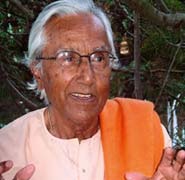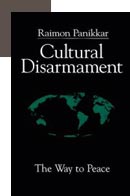

el sitio oficial


Cultural Disarmament
The Way to Peace
The theme of peace runs explicitly and implicitly throughout all the work of Raimon Panikkar, and it could not be otherwise. Nonetheless, the history of the human species appears to contradict once again this axiom that peace and religion are united in an indissoluble manner, be it interior, personal and spiritual peace, or political peace between peoples and communities. It can even be affirmed that all the times (and there have been so many in the course of history) that a religion has not promoted peace or has not opposed war or has fomented it (and all religions have done so), that religion has betrayed its own reason for existence and has negated its spiritual nature.
But Panikkar does not limit himself to formulations of this type, however obvious or necessary it may be today and always: during all of his life as a religious person, a teacher and a writer, he has investigated the theme of peace seeking to identify the tracks to follow in order to make possible this necessary utopia. Peace is on everyone’s tongue these days, but its achievement seems some kind of unlikely miracle, if we focus on the reality of the events and news that we are exposed to daily telling us of so many wars underway. The very fact that it is something we all yearn for, that it is something we all affirm that we want to realize even though it may never be realized (although peace is theoretically realizable through simple human good will) tells us the degree to which the myth of war is still predominant over the myth of peace. Therefore “it is not realistic to toil for peace if we do not proceed to a disarmament of the bellicose culture in which we live.”
To sketch out the myth of peace means to reveal its religious dimension: that it is not to achieve a future result but rather to find a continuing path. “Hope is not in the future, but in the invisible.” What occurs, submits the author, is not a revolution but a metamorphosis. “The radical metanoia … does not mean to espouse another ideology, but rather to transcend (but not negate) the field of the mental itself, to transcend the nous”.
Peace is not something that is imposed, that one gives or merits: peace is a gift that is received by grace, freely. This attitude of receptivity is the foundation to peace. The religious dimension of peace radiates from here: or better, the change in the religious vision of war. Most wars, in fact, have and have had religious connotations or at least justifications: even contemporary wars, that appear to have an exclusively political character, are at a minimum, “inspired by a religious ethos: to save Civilization, Freedom, Democracy, all with a capital letter.” Thus we have the fundamental thesis of the book: a preventative cultural disarmament is necessary in order to walk straight on the path of peace. “By cultural disarmament I understand the abandonment of the rut in which modern culture of Western origin has been entrenched: progress, technology, science, democracy and the world economic market are things acquired and are negotiable values […]. Disarmament is to make oneself vulnerable and must be realized slowly, but forms an essential condition for being able to establish a dialogue in parity with all the cultures of the earth."
Rich in enlightening intuitions, the book concludes with a chapter entitled “Paths to Peace”. Panikkar starts from the assumption that “peace is not obtained by a treaty, just as love is not conquered by decree” because “in the nature of peace, as in love, there is something that obeys no orders”. Panikkar remembers that “only reconciliation arrives at peace” and dialogue is the only possible road to reconciliation: “ not a dialogue to arrive at a solution, but a dialogue for being, because I am not without the other”. In conclusion: si vis pacem, para te ipsum.
translation from Italian
